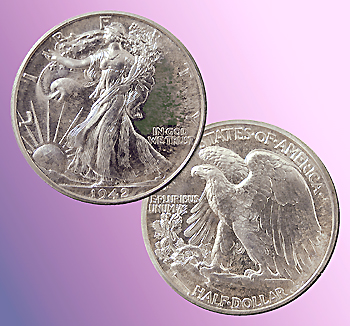Walking Liberties: A Handsome Half-Dollar Series
|
"Making Cents"
The Signal
Saturday, November 5, 2005
| T |
The design was conceived by artist and engraver A.A. Weinman. His initials appear as the monogram, "AW"; actually it is "AAW" at the 5 o'clock position on the reverse ("tails" side) under the eagle's wing tip.
The design was inspired by then-current French coinage, which featured a standing figure of Liberty.
The reverse design shows a perched eagle clutching a scrub pine growing out of a rocky crag. The pine symbolizes the emergence of a hardy species under trying natural conditions. The outspread wings indicate the posture of ready for flight — a forward-looking pose for the country.
Liberty is striding toward the sunrise with one hand extended and the left holding an olive branch — a symbol of peace. Her flowing shawl is star-studded. All the symbols reflect the views of an emerging nation with hopes for the future.
Walking Liberty half dollars were minted every year except 1922, 1924, 1925, 1926, 1930, 1931 and 1932. Mintage figures were generally under 10 million a year except for 1917, 1918-S and 1936; then, starting in 1941, mintage figures rose to several times that level with a high of 53 million in 1943.
In 1916 and the early part of 1917, the mint-marked coins bore the mint marks on the front. By late 1917, mint marks were moved to the back at 8 o'clock, just under the scrubby pine.
Scarce pieces in the series in all grades include 1916, 1916-D, 1916-S, 1917-D obverse mint mark, 1917-S obverse mint mark, 1921, 1921-D, 1921-S and 1938-D. The rest are valued at bullion value in circulated grades. In uncirculated condition, almost all of the coins in the series have a value of $40 or higher.
Starting in 1936 and ending in 1942, proof coins were minted each year in Philadelphia. These coins vary in value from the scarcest, 1936, at $4,000, to the last issue, 1942, valued at $650.
Often considered one of America's top three artistic coin designs, the series was replaced in 1948 by the Ben Franklin half dollar.
Complete circulated sets are offered for sale by dealers from time to time at modest prices. Uncirculated sets are rarely encountered, since the single coins such as the 1921 can bring several thousand dollars at a public auction.
It is not a difficult set to complete — but mainly from public auctions and dealers' fixed price lists. When finished, it is a very handsome display.
Dr. Sol Taylor of Sherman Oaks is president of the Society of Lincoln Cent Collectors and author of The Standard Guide to the Lincoln Cent. Click here for ordering information.
©2005, THE SIGNAL · ALL RIGHTS RESERVED.
